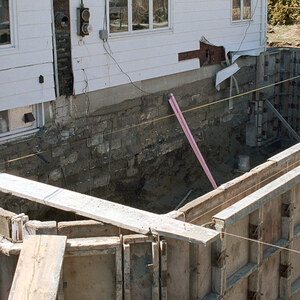*
I have a rather unusual problem. I am seeking to restore a front porch floor to its original appearance. The house was built in 1918 and had a tongue and groove wood plank floor on its front porch. The floor is long since gone, replaced by a poured concrete slab. I would like to put down a new plank floor over top of the existing slab. Laying it over pressure treated sleepers was my first thought. This would allow any water that found its way through to fall to the slab and run off underneath. Then a friend suggested that I glue the planking directly on the slab, and do my best to “seal” the whole surface so as to keep any water from getting through in the first place. The porch slab is covered by a full roof, but any wind driven rain does succeed in wetting the majority of the floor area. If I try a direct application, what adhesive should I use? If the sleepers are a better idea, that’s fine too. In either event, how should I prepare the slab for whatever adhesive or fasteners I intend to use? And one final question: what material should I use for the flooring itself? Pressure treated fabricated into tongue and groove? I have a router table so that is not a problem to do. How about some of the new composite materials? Any advice with respect to any one of the questions would be greatly appreciated. I know if there is an answer, I will find it here. Thanks again.
Tom
Discussion Forum
Discussion Forum
Up Next
Video Shorts
Featured Story

The "She Build" initiative is empowering women in Seattle, WA by ensuring they have safe, healthy homes.
Featured Video
Video: Build a Fireplace, Brick by BrickHighlights
"I have learned so much thanks to the searchable articles on the FHB website. I can confidently say that I expect to be a life-long subscriber." - M.K.

















Replies
*
Tom:
I'm no deck building expert, but disregard your friends advice. I would think it would be wise to allow for some vertical height spacing with the sleepers on the slab, otherwise moisture or standing water may eventually destroy it.
I'm sure others can help with the rest.
*Hey Tom,Sleepers......no doubt about it.Presure treated is not a bad idea, but putting the T&G on with a router table is not such a fine idea in my opionion. Too small a tool for such a big job. I'd farm it out to a mill if I were you.This is not a good situation. Wood over concrete is bad anyway you look at it in my opinion. But you never know. Make sure there is drainage.I'm sure you will have lots of other opinions here.Good luck,Ed.
*
I have a rather unusual problem. I am seeking to restore a front porch floor to its original appearance. The house was built in 1918 and had a tongue and groove wood plank floor on its front porch. The floor is long since gone, replaced by a poured concrete slab. I would like to put down a new plank floor over top of the existing slab. Laying it over pressure treated sleepers was my first thought. This would allow any water that found its way through to fall to the slab and run off underneath. Then a friend suggested that I glue the planking directly on the slab, and do my best to "seal" the whole surface so as to keep any water from getting through in the first place. The porch slab is covered by a full roof, but any wind driven rain does succeed in wetting the majority of the floor area. If I try a direct application, what adhesive should I use? If the sleepers are a better idea, that's fine too. In either event, how should I prepare the slab for whatever adhesive or fasteners I intend to use? And one final question: what material should I use for the flooring itself? Pressure treated fabricated into tongue and groove? I have a router table so that is not a problem to do. How about some of the new composite materials? Any advice with respect to any one of the questions would be greatly appreciated. I know if there is an answer, I will find it here. Thanks again.
Tom